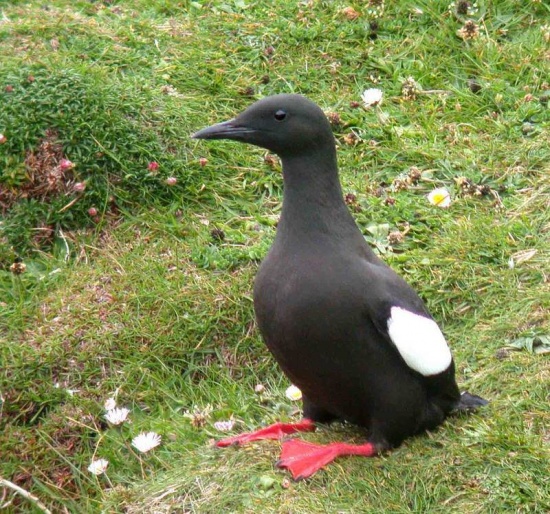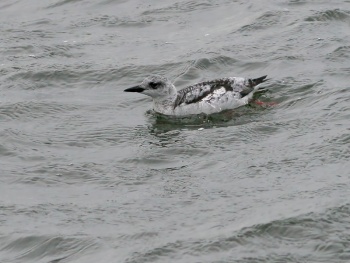(Winter plumage & flight pictures uploaded. Some extra information added) |
(Add External Link) |
||
| Line 34: | Line 34: | ||
''[[Media:Cepphus grylle (song).mp3|Listen in an external program]]'' | ''[[Media:Cepphus grylle (song).mp3|Listen in an external program]]'' | ||
==External Links== | ==External Links== | ||
| + | *[http://www.arthurgrosset.com/europebirds/blackguillemot.html Arthur Grosset's Birds] | ||
{{GSearch|Cepphus+grylle}} | {{GSearch|Cepphus+grylle}} | ||
[[Category:Birds]] [[Category:Cepphus]] [[Category:Bird Songs]] | [[Category:Birds]] [[Category:Cepphus]] [[Category:Bird Songs]] | ||
Revision as of 19:59, 18 August 2009
- Cepphus grylle
Identification
L. 33 cm
Ws. 53 cm
Wt. 430g g
- Chunky
- Round-winged seabird
Adult
- All black except white upperwing coverts
- Bright red legs and gape
Similar Species
Appearance, voice, and behavior almost identical to Pigeon Guillemot.
Distribution
Breeds in Iceland and the Faroes, Jan Mayen, Bear Island, Svalbard and Franz Josef Land, north and west British Isles, around the north coasts of the Baltic and islands in the Kattegat, coastal Norway to the Murmansk Coast and the White Sea, and on Kolguyev and Novaya Zemlya.
Most populations are resident with little or no movement away from breeding sites but in the far north most birds move southwards. Birds from Finland and Gulf of Bothnia winter mainly off south-east Sweden. Occasionally seen south of main range in winter, annually recorded in Netherlands, more rarely south to northern France and Belgium and exceptionally recorded in Czechoslovakia and Yugoslavia. Recently recorded off Spain. They are also found in Eastern North America as well.
Taxonomy
Five races occur in the region but separation at sea is rarely possible.
Most distinctive is mandtii from Jan Mayen, Bear Island and Svalbard, with whiter upperparts in non-breeding plumage. Remaining races, nominate grylle from the Baltic, arcticus from British Isles to Arctic Russia, faroeensis from Faroes and islandicus from Iceland are all very similar, differing only in minor measurements.
Habitat
Colonial breeder in boulder piles at the base of cliffs and on scree-covered slopes on low rocky islands and coasts. Winters mainly in sheltered bays close to breeding site.
Behaviour
Not particularly sociable, rarely seen in large groups or with other auks.
Breeding
They breed singly or in small scattered colonies and lay their eggs in rocky crevices near water.
Diet
The diet includes fish and crustaceans, molluscs, insects and plant material.
Vocalisation
A weak high-pitched whistle
<flashmp3>Cepphus grylle (song).mp3</flashmp3>
Listen in an external program






